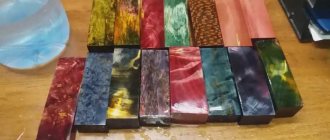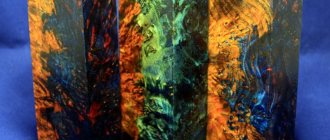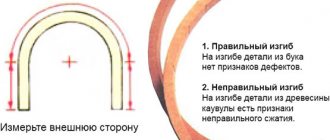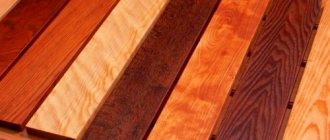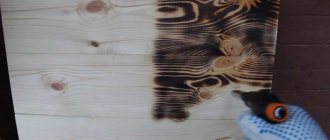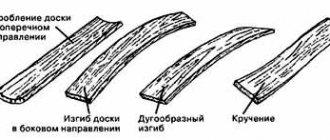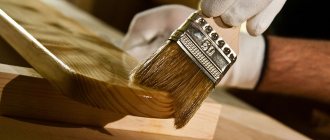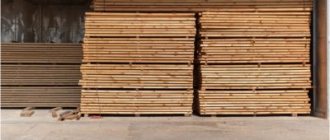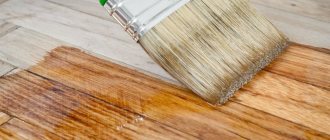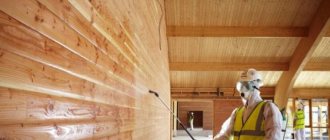Wood is a noble and beautiful material. However, fibers are subject to change over time; processes occurring in wood irreversibly lead to its destruction. Stabilization of wood allows preserving its original qualities. Thanks to this manipulation, the destructive processes in the fibers of the material are completely stopped, in addition, it takes on a more attractive appearance.
Description of technology
The purpose of stabilization is to protect the wood from moisture. The material is treated with a special compound, which makes the fibers stronger and more durable.
In industrial volumes, this method of stabilizing wood is practically not used, since in large volumes the cost of processing is high.
As a result of exposure to a special solution, all internal processes in a piece of wood are suspended, it becomes more durable, and the fibers undergo polymerization.
The compositions that act on the material clog the pores and fill all the free space between the fibers.
Not all wood is suitable for stabilization. The following breeds respond well to processing:
- beech;
- hornbeam;
- maple;
- birch.
Some rocks are less susceptible to stabilization and should be processed under pressure:
- oak;
- elm;
- walnut and similar wood density species.
Amaranth and ebony are resistant to stabilization and should not be treated with this method of processing.
The main process underlying the transformation of the material is filling the pores of wood with a special composition. Technological nuances may differ depending on the composition used. Polymerization is carried out with varnish in a vacuum or other means, and the effect can be achieved by impregnating the material with resins and oils.
Treatment with Anacrol-90
The container in which the block or wood product will be placed should be completely filled with the composition. Next, vacuum conditions are created in a special chamber.
The impregnation process is accompanied by the release of air bubbles, which indicates that the composition penetrates into the wood and pushes air out. After the “seething” effect disappears, the workpiece should be kept in the solution for about half an hour under pressure. For these purposes, you can use a special pump or compressor.
After all stages of processing have been completed, the process should be repeated, but not earlier than after 30 minutes. The detector of the completion of filling the fibers with the polymer composition is the loss of the wood’s “buoyant” properties. If the product floats in a container filled with a solution, it means that the pores are not completely filled, and the process must be repeated.
The final touch is drying at a temperature close to 100 ⁰C.
If you add a dye to Anacrol-90, it will give an interesting color effect on the wood after stabilization.
Requirements for workpieces for stabilization
Before moving on to the description of the stabilization process, let me remind you of the requirements that must be placed on wooden blanks in order to obtain a high-quality result. The impregnation process is the process of penetration of a solution (in our case Anacrol®-90 ) into the pores of the material; accordingly, if the pores are “closed” (with water, resins, salts), the composition will not penetrate into them, and if they are too large (about 0. 5mm), it will not “stay” there.
The main requirement: the tree must be as dry as possible. The recommended thickness of the bars is no more than 40mm.
Stabilizing compounds
Most often, compositions with high polymerization ability are used. Most often used:
- polymers;
- oils;
- resins;
- paints and varnishes.
Liquid glass
The product is for home use and has a reasonable price. After treating wood with this product, an additional protective film is formed on its surface, which does not allow all kinds of dyes to penetrate inside.
Most often, the composition is used to stabilize sources for decorative products that will come into contact with aggressive chemicals. The composition reliably protects against fungi, including mold, and also protects against high temperatures, exposure to moisture and ultraviolet rays.
Epoxy resin
This product is applicable to almost any type of wood, with the exception of coniferous species.
When stabilizing the bars, you should pay attention to the fluidity of the solution. The rate of filling of wood pores directly depends on this property. It is better not to use a composition that is too thick, or dissolve it in alcohol.
When heating the resin in a vacuum, it may boil, so the entire process requires monitoring.
Brine
To prepare this composition you only need to dissolve 1 tbsp. l. salt in 1000 ml of water. The method of processing with this means is the least expensive, but more labor-intensive. To stabilize wood, it should be boiled in a salt solution for at least 2 hours.
Birch juice
The most environmentally friendly and harmless composition that does not release toxins when heated. At the same time, the juice is an excellent polymerizer.
To ensure deep penetration of the stabilizing composition deep into the wood, it is necessary to carry out the process in a vacuum chamber, and the processing should be completed in a drying chamber or oven at 90 ⁰C.
Another advantage of birch sap is that it can be easily mixed with natural dyes.
Drying oil
This substance is considered optimal for stabilizing wood intended for all kinds of crafts, as well as furniture and decorative elements for outdoor installation. The required viscosity of drying oil is achieved by adding a solvent to it.
Composite and alkyd solutions are used for wood that will be used for external cladding, and drying oil based on natural components is more suitable for stabilizing furniture and decorative elements.
Oils
Natural flaxseed or any other oil can also be used as a stabilizer.
Curing of the ANACROL-90 composition (heat treatment)
Heat treatment of workpieces can be carried out in two ways:
1) In boiling water (or industrial oil) – soaked workpieces are tightly wrapped in stretch film (cling film) and placed in hot (boiling) water (95±5) ºС, where they are kept for about 1-2 hours (for metal products: 20-30 minutes, without film). 2) In a drying chamber (for example: oven, oven) - the impregnated workpieces are placed in an oven heated to 120-140 ºС. Highly porous (loose) wood must be wrapped, for example, in a baking bag; this procedure is necessary to prevent Anacrol-90 . Drying lasts from 2 to 4 hours, the process ends when the wood stops “hovering” and there are no wet spots.
Important! If the temperature regime is violated (for example: the workpieces were placed in an oven heated to 90-95 ºС), the polymerization process will not occur properly, the composition will be like “rubber”. If you try to correct the situation in the future and subject the workpieces to repeated heat treatment, this will lead to nothing, the composition will remain the same.
Polymer stabilizers
Polymers act quickly because they are capable of maximally filling the pores of the material in a short period of time. They are used for processing wood using a vacuum. Some solutions can also be used at home.
"Buravit"
A low-viscosity polymer composition that is able to quickly penetrate the pores of wood, filling even the smallest free spaces. Thanks to the optical pigments in the product, the treated material acquires a more saturated fiber pattern.
"Anacrol90"
Designed for stabilization in a vacuum chamber.
The main active ingredient of the solution is polyester, which is converted into a polymer under the influence of high temperatures. The composition ensures the resistance of the treated wood to chemical reagents, as well as mechanical stress.
"100TERM"
The composition is a solution of medium viscosity containing polymers that change their density under the influence of heat. This product is popular for use in both industrial and domestic environments.
The polymer is supplied in tin cans, convenient for storage and transportation.
"Pentacryl"
This product is safe for household use because it does not contain toxic substances. At the same time, it penetrates deeply into the structure of the wood and also saturates the fibers with fat-soluble pigments, which make the design brighter and more expressive. The composition is made on the basis of alkyds.
Polymers
Modern polymer-based impregnations are often used to stabilize wood. The most popular of them are:
"Anacrol-90"
Polyester impregnation for wood, which under the influence of high temperatures turns into a thermosetting polymer. Due to its high strength, resistance to chemical attack and temperature changes, the composition is widely used for the preservation of small cracks and pores in wood.
"100therm"
A transparent liquid composition based on thermosetting polymer components is intended for reliable conservation of wood. It is convenient and easy to use, suitable for application in industrial and home environments.
"Buravid"
A transparent polymer composition, including optical pigments, which is intended for the polymerization of wood. Its viscosity and density resembles water, but when exposed to temperature it turns into a hard coating. Provides protection from moisture, ultraviolet radiation, biological contamination, and emphasizes the natural structure of wood fibers.
Equipment
Processing materials using polymers requires additional equipment. The main equipment for stabilizing wood is a vacuum chamber and a drying oven.
The vacuum chamber can be assembled at home using:
- plastic containers;
- Vacuum pump;
- tubes and valves;
- compressor; pressure gauge
Instead of a drying cabinet, you can use an oven, but you should take into account the volatility of paints and varnishes under the influence of temperatures and ensure good ventilation.
"COLLECTIVE FARM" STABILIZATION
0) I weigh the absolutely dry block (let it dry even if the hygrometer is at 0!) and write it down. 1) cut the plastic bottle to the desired height. A bottle without a “waist” so that the bar fits tightly into it. 2) I don’t pour a lot of liquid into this bottle - so that the bar floats but does not rise above the cut. If the block is pushed in tightly, it should be immersed 1/2-2/3. The top of the block must remain dry - this is important! 3) I put the resulting 1 liter jar (800 ml, 1.5 liter - whatever is available and fits the size) 4) I pump out the air 5) after the liquid rises through the capillaries to the very top of the bar, I release the vacuum and add liquid so that the bar is completely immersed . You may need to weigh it down with a weight. 6) I give a vacuum. As soon as it stops bubbling, I reset it, keep it under a layer of liquid for an hour and vacuum again. Repeat the cycle until completely saturated. Indicators that impregnation is complete: 1) the block has sunk (not necessary, some rocks do not sink) 2) during the next vacuum cycle there are absolutely no air bubbles. 3) when weighing, you can see that you have gained from 30 to 120 grams of slurry (depending on the initial density, say for wenge and zebrawood it is usually 40-60 grams per standard, and birch sleeper can gain 150) You can start maintenance . THEN 1) I let the block flow around on the grill or wipe it with a paper napkin 2) I wrap the block tightly in aluminum foil. I make sure that the foil sticks to the bar and that there are no bubbles left. After this, you can secure the foil with tape and put it in the oven for 100-120c. But I continue. 3) I wrap it in stretch film - tightly, hermetically but in no more than 2 layers. 4) on top of the stretch - tape. Wide. Dense, airtight but no more than 2 layers. I cook in a pressure cooker - 1 hour. Sometimes even half an hour is enough if it’s small. But you can just do it in a saucepan, but it takes two hours. And someone says 3... Depends on the liquid. I take it out, peel it, weigh it. For poplar, I repeat everything from the very beginning, from drying and impregnation. A labor-intensive but very interesting process. Py. Sy. If you have a stove, it’s much easier. If the vacuum cleaner is not manual, it’s even easier. The camera makes it even easier. A chamber holding pressure and a compressor do not simplify things, but they speed things up significantly, improve quality and allow you to stabilize denser and more interesting rocks.
Properties of stabilized material
A tree that has undergone such processing acquires new qualities:
- resistance to moisture;
- immunity to chemical influences, including aggressive organic substances;
- high strength;
- long service life;
- resistance to temperature and humidity changes;
- resistance to ultraviolet radiation, no fading effect;
- maintaining the integrity of the structure during short-term contact with open fire.
At the same time, stabilized wood retains its original color (provided that dyes are not used) and shape. Despite the increased density, the recovered material can be machined into the desired shape. It can be sawed, ground, cut, sanded and polished.
Benefits of the procedure
Stabilization is a special type of wood treatment that involves safely filling the pores with protective compounds.
Its main goal is to maintain the decorative properties of wood while increasing strength, hardness and resistance to external factors. A similar effect is achieved through the use of special compounds that have the ability to polymerize.
This is a rather labor-intensive and responsible process, the organization of which must be approached with full responsibility and the sequence of actions must be followed in accordance with the chosen technology.
Thanks to conservation, wood acquires the following characteristics:
- density and hardness;
- resistance to high moisture, temperature changes and ultraviolet radiation;
- flame resistance;
- impermeability to paints and varnishes;
- resistance to chemical and biological influences;
- inertness to deformation and rotting;
- decorativeness and aesthetics;
- susceptibility to manual and mechanical processing.
Benefits of stabilization
Wood treated in this way becomes stone-like in both strength and structure. This is not only a structural advantage, but also a decorative one.
This stabilization method is rightfully considered one of the most effective. Due to the deep effect on the fibers, filling the pores and the entire internal space with polymer, the entire structure is subject to treatment. This effect cannot be achieved in other ways, for example, by surface coating with a layer of varnish that protects only the top layer.
What is wood stabilization
In the process of mechanical processing of wood, various techniques and methods are used - sawing, planing, grinding, carving. During all this work, the natural order of the fibers is disrupted. Some of the fibers are revealed along the entire length, some are broken in the cross section. As a result, after all the manipulations, a product of the desired shape is obtained. But along with obtaining the desired shape, the tree itself becomes even more unprotected from external influences. Treated fibers will still retain the ability to absorb moisture, which can lead to the development of fungal infections and rot.
This state of affairs can only be changed by resorting to the use of stabilization technology or treating the wood with a special composition that can penetrate deep into the pores and literally clog the pores. The wood stabilization process is complex in nature. In the process of stabilization, wood acquires not only qualities that increase its strength and hardness, but also a more interesting appearance.
Main goals of stabilization
Despite the laboriousness of the process and the rather long time that will be spent on stabilization, the result will ensure ease of processing of the workpiece. Thus, during processing, special compositions make it possible to achieve the following material properties:
- Increase the density and hardness of wood;
- Ensure resistance to moisture, pressure and temperature changes, protect from ultraviolet radiation;
- The tree becomes resistant to high temperatures and open flames;
- Materials impregnated with polymers adhere better to paint and varnish coatings;
- The wood becomes impenetrable to biological pests;
- Fibers impregnated with polymer are no longer subject to deformation, wood becomes easier to process and glue;
- When processing manually and instrumentally, you can get a better result - the material changes its properties, it becomes easier to process.
Application of technology
The stabilization method is used to strengthen wood. Material intended for:
- furniture production;
- production of decorative elements;
- crafts and toys;
- manufacturing handles for knives, tools and other products.
Application of stabilized wood
The process of stabilizing wood can significantly simplify the creation of many items with wooden inserts and elements. In practice, the use of stabilization makes it possible to use soft types of wood for the manufacture of tool handles. This material makes comfortable handles for files; the handles of cutters and chisels are not afraid of impacts, and they last much longer than handles made of soft wood. Stabilized wood is also great for making knives. Wooden overlays are durable and comfortable.
Stabilization techniques are also used by master gunsmiths - stabilized wood makes excellent stocks and butts for guns. Moreover, stabilization is often used by master modelers; it is from this material that models of sailing ships and historical ships are made.
Wood stabilization technology is also indispensable for furniture makers; almost all furniture parts made of natural wood require such impregnation. Thanks to stabilization, products last much longer, because wood impregnated with polymer resin is not subject to warping or changing shape.
Stabilization methods at home
You can strengthen wood with your own hands, without the use of specialized equipment.
Epoxy Resin Process
Technology has its own characteristics. The process itself is similar to that described above. However, the key indicator that must be avoided is the resin boiling under vacuum. If this moment is missed, the wood may be damaged.
Epoxy resin has a fairly high viscosity, so it needs to be diluted with alcohol, which takes a lot of time. The stabilization process itself also requires a significant amount of time and careful monitoring of the process.
Stabilization methods
There are 4 ways to stabilize wood:
- Cold impregnation. This is perhaps the simplest option for stabilizing wooden products. Stabilization is very simple - the workpieces are soaked in a cold composition, usually in an airtight container. The impregnation period for wooden blanks varies from 2 days to 2 weeks. Typically nut, hemp or flaxseed oil is used, but commercial oil-based formulations can also be used.
- Hot impregnation. This method is considered the most effective, since during hot impregnation all pores are filled with the composition. The complexity of the method lies in the fact that three-dimensional wooden parts cannot be stabilized due to the complexity of the technological process.
- Vacuum processing. The method of stabilization under vacuum is difficult to implement, but the result is worth all the costs. To process wood you will need a vacuum chamber. The first step is to pump out the air from the chamber, after which the liquid pumped out from the pores of the wood is removed. After this, a special composition is drawn into the chamber, and then pressure is applied back, as a result, the pores are filled with a stabilizing composition. Finally, work is carried out on the polymerization of the impregnation.
- Processing under pressure. This method is generally similar to the previous one, only now the processing is carried out under high pressure, and the stabilizing composition can be pumped in immediately.
Main goals of stabilization
The primary task is to protect the wood from the negative effects of moisture. After impregnation, the fibers become impervious to all kinds of liquids and chemical treatments. They do not increase, do not lose their performance characteristics, and retain their shape and color.
This procedure is not just impregnation, but filling the entire available space between the fibers. For this purpose, protective compounds are used that clog pores.
Stabilization helps improve the consumer qualities of wood. The best effect can be achieved with compositions that have the ability to polymerize. Most often used for this purpose:
- natural resins,
- polymers,
- paints and varnishes,
- all kinds of oils.
